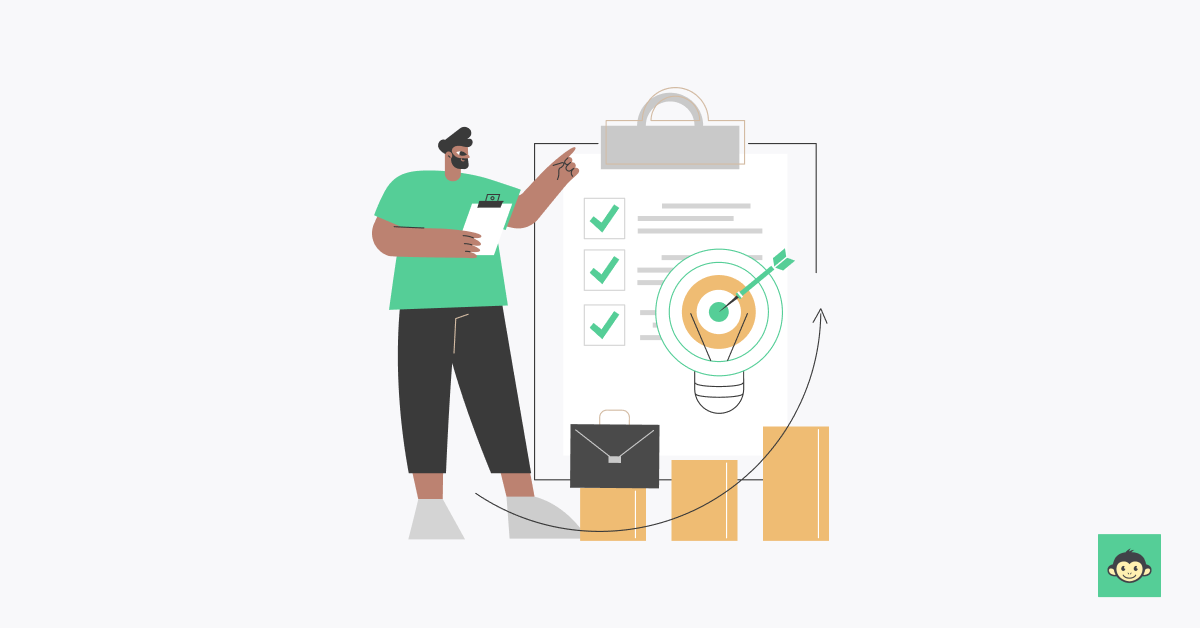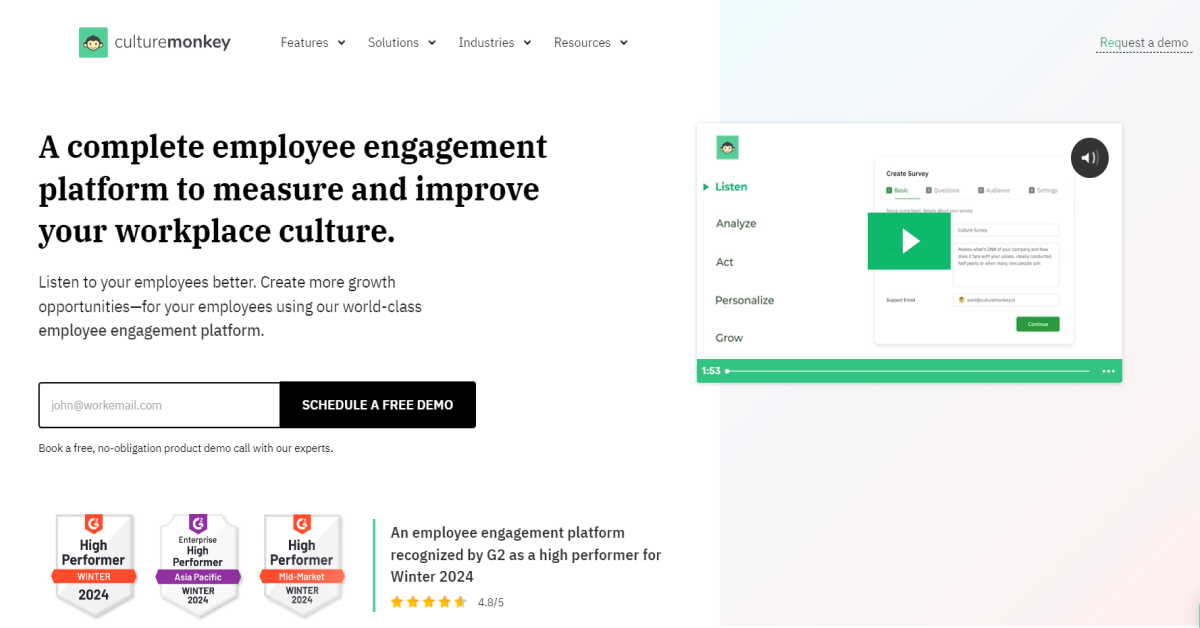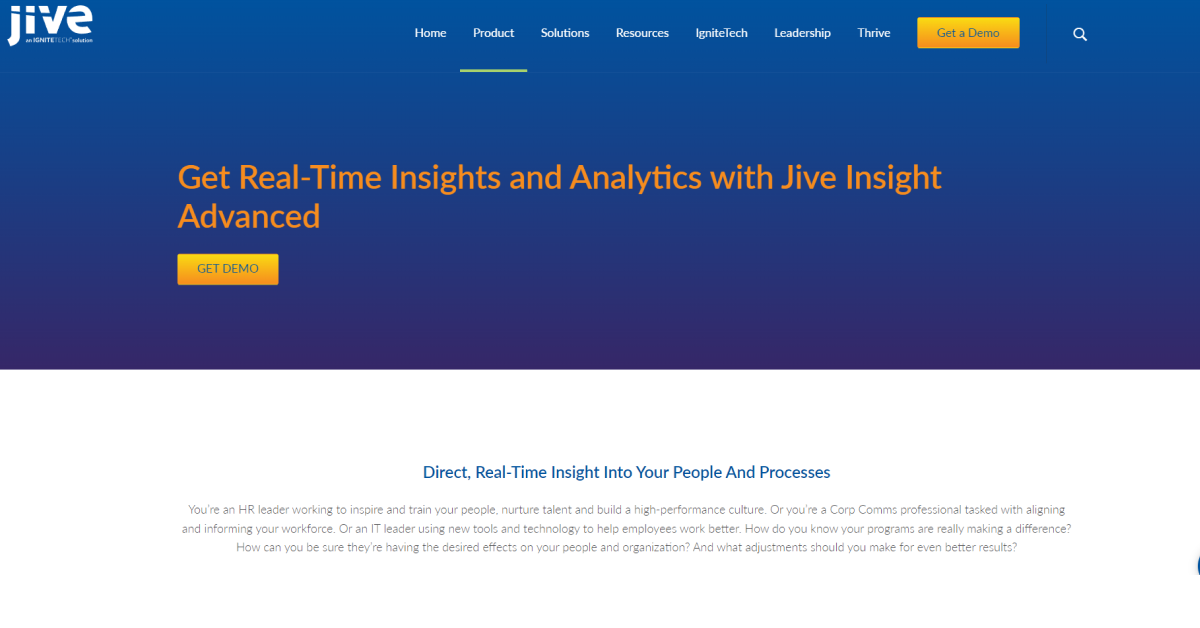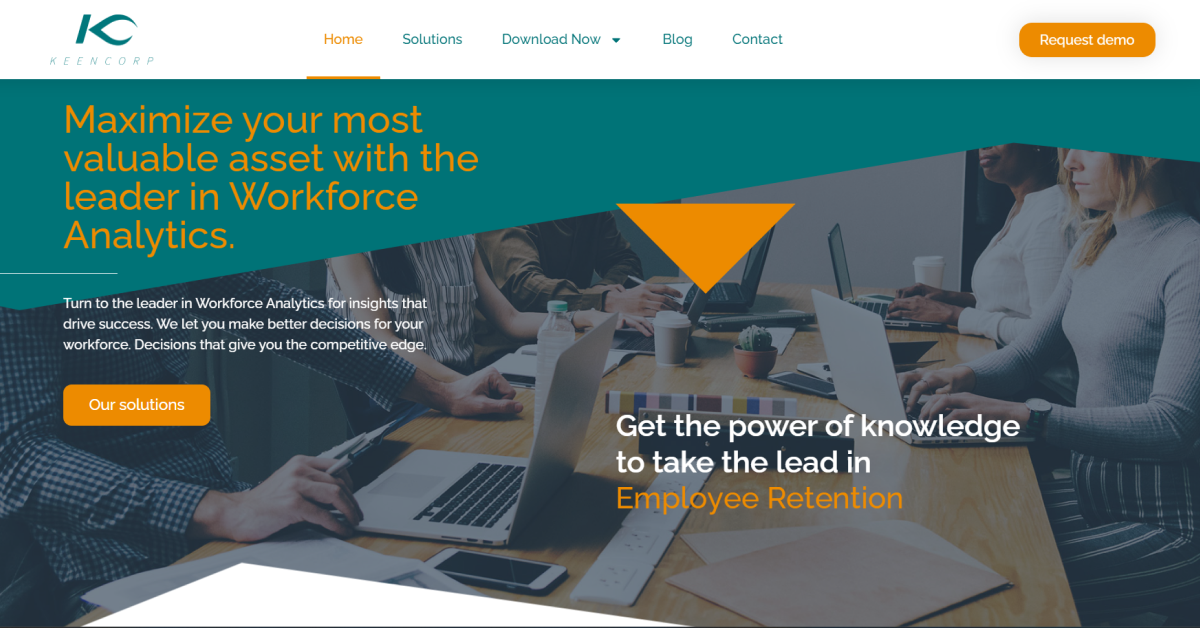What is employee sentiment analysis: Definition, best practices, and top tools to try in 2024

Happy employees are productive employees. It's a simple truth, but in today's competitive job market, keeping your workforce happy and engaged can be a challenge.
This is where employee sentiment analysis comes in. By understanding how your employees feel about their work, their colleagues, and the company culture, you can proactively address concerns and create a more positive work environment.
In this blog post, we'll explore employee sentiment analysis, covering its definition, workings, and importance. We'll also explore some of the best practices for using sentiment analysis tools and provide a sneak peek at the top options to try in 2024.
What are employee sentiments?

Employee sentiments refer to the collective attitudes, emotions, and opinions that employees hold towards their work, colleagues, managers, and the overall organization.
These sentiments can range from positive feelings, such as satisfaction, motivation, and loyalty, to negative sentiments, such as frustration, dissatisfaction, survey fatigue and disengagement.
Understanding employee sentiments is crucial for organizations as it provides insights into the overall morale and well-being of the workforce.
By analyzing employee sentiments, businesses can identify areas of improvement, address concerns, and implement strategies to enhance employee engagement, productivity, and retention.
Additionally, monitoring employee sentiments allows organizations to proactively address issues before they escalate, ultimately contributing to a positive work culture and better organizational performance.
What are the types of employee sentiment, and why is tracking it important?

Employee sentiment can be categorized into various types based on the emotions and attitudes expressed by employees. Some common types of employee sentiment expressed include:
Positive sentiment:
- Satisfaction and employee happiness: When employees express positive sentiments, they typically exhibit high levels of job satisfaction and contentment. They feel fulfilled by their work, find meaning and purpose in their roles, and derive a sense of accomplishment from their contributions.
- Enthusiasm and motivation: Positive sentiment often translates into enthusiasm and motivation. Employees who feel positively about their work are more likely to be proactive, innovative, and willing to go above and beyond to achieve organizational goals.
- Loyalty and commitment: Positive sentiment fosters loyalty and commitment among employees. They develop strong bonds with the organization, exhibit higher levels of loyalty towards their colleagues and managers, and are more likely to stay with the company for the long term.
Negative sentiment:
- Frustration and dissatisfaction: Negative sentiment may stem from various sources, such as unrealistic workloads, unclear expectations, or lack of recognition. Employees experiencing frustration and dissatisfaction may feel undervalued, unappreciated, or marginalized within the organization.
- Stress and burnout: High levels of negative sentiment can contribute to stress and burnout among employees. Persistent feelings of stress and overwhelm can lead to decreased productivity, increased absenteeism, and a decline in overall mental health and well-being.
- Disengagement: Negative sentiment is often associated with disengagement, where employees feel disconnected from their work and disinterested in organizational goals. Disengaged employees are less motivated to perform at their best and may exhibit lower levels of productivity and commitment.
Neutral sentiment:
- Indifference or apathy: Neutral sentiment may indicate a lack of strong emotional investment in the organization or job role. While not necessarily negative, neutral sentiment suggests that employees may not feel particularly engaged or passionate about their work.
- Possible opportunity for improvement: Neutral sentiment provides an opportunity for organizations to delve deeper into understanding employee perceptions and identify areas where improvements can be made to enhance overall satisfaction and engagement.
Mixed sentiment:
- Complex emotional landscape: Mixed sentiment reflects the complexity of employee experiences, where individuals may simultaneously hold both positive sentiments and negative feelings towards different aspects of their work or workplace.
- Contextual understanding: Understanding mixed sentiment requires a nuanced approach, considering the contextual factors that contribute to employees' emotional experiences. By acknowledging and addressing both positive and negative sentiments, organizations can work towards creating a more balanced and supportive work environment.
What is employee sentiment analysis?

Employee sentiment analysis is the process of systematically evaluating and interpreting the attitudes, emotions, and opinions expressed by employees within an organization.
It involves gathering data from various sources such as surveys, feedback forms, performance reviews, social media platforms, and communication channels, and then using natural language processing (NLP) and sentiment analysis techniques to analyze the text and derive insights.
The goal of employee sentiment analysis is to understand the overall mood, perceptions, and concerns of the workforce, and to identify patterns, trends, and areas for improvement.
By analyzing and measuring employee sentiment, organizations can gain valuable insights into factors affecting employee engagement, job satisfaction, morale, and well-being.
Employee sentiment analysis allows organizations to monitor employee satisfaction, identify issues and concerns, measure engagement, track changes over time, and make informed decisions based on insights derived from sentiment analysis.
Benefits of employee sentiment analysis

Employee sentiment analysis offers organizations invaluable insights into the thoughts, feelings, and perceptions of their workforce.
By systematically evaluating employee sentiments, organizations can unlock numerous benefits that contribute to a thriving workplace culture and enhanced organizational performance.
- Proactive issue resolution: By identifying issues and concerns raised by employees through sentiment analysis, organizations can take proactive measures to address them before they escalate, fostering a more positive work environment and improving employee morale.
- Improved communication and collaboration: Sentiment analysis enables organizations to identify communication gaps or issues affecting collaboration among employees, empowering them to implement measures that promote better communication, teamwork, and synergy within teams.
- Tailored interventions: With insights from sentiment analysis, organizations can tailor interventions and initiatives to meet the specific needs and preferences of their workforce, ensuring that resources are allocated effectively and initiatives are impactful in addressing employee concerns.
- Data-driven decision making: Sentiment analysis provides organizations with data-driven insights that inform decision-making processes related to human resources, organizational policies, and employee wellness initiatives, enabling them to make informed decisions that align with the needs and priorities of their employees.
- Retention and talent management: Understanding employee sentiment helps organizations identify factors influencing retention and talent management, allowing them to implement strategies that improve employee satisfaction, foster loyalty, and reduce turnover rates, ultimately retaining top talent and enhancing organizational stability.
- Enhanced organizational culture: Sentiment analysis contributes to building a positive organizational culture by addressing issues that impact employee satisfaction and well-being, fostering a supportive and inclusive work environment where employees feel valued, respected, and motivated to contribute their best.
- Continuous improvement: By tracking changes in employee sentiment over time, organizations can assess the effectiveness of interventions and initiatives aimed at improving the workplace environment, facilitating continuous improvement and adaptation to evolving employee needs and preferences, ensuring that the organization remains responsive and aligned with employee expectations.
Employee sentiment analysis: 10 Top best practices

Employee sentiment analysis is a powerful tool for organizations to gain insights into the emotions, attitudes, and perceptions of their workforce. To maximize the effectiveness of sentiment analysis initiatives, here are ten best practices to consider:
- Define clear objectives: Clearly outline the goals and objectives of the sentiment analysis initiative, determining specific insights you aim to gain and how they will contribute to organizational goals.
- Select appropriate data sources: Identify relevant data sources for sentiment analysis, including employee surveys, feedback forms, performance reviews, social media platforms, and communication channels.
- Ensure data quality: Ensure that the data collected for sentiment analysis is accurate, relevant, and representative of the entire workforce, taking steps to minimize bias and ensure data integrity.
- Use advanced analytical techniques: Leverage advanced analytical techniques, such as natural language processing (NLP) and machine learning algorithms, to analyze and interpret employee sentiment accurately and efficiently.
- Segmentation and contextualization: Segment employee data based on factors such as department, tenure, and job role to gain a deeper understanding of sentiment within different groups, contextualizing sentiment analysis findings to understand the underlying reasons behind employee emotions.
- Regular monitoring and tracking: Establish a regular cadence for monitoring and tracking employee sentiment over time, allowing organizations to identify trends, patterns, and changes in sentiment and take timely action.
- Promote transparency and communication: Communicate the purpose and outcomes of sentiment analysis initiatives transparently with employees, encouraging open dialogue and feedback to foster trust and engagement.
- Integrate with organizational processes: Integrate sentiment analysis findings into organizational processes, such as performance management, employee engagement initiatives, and decision-making processes, to drive meaningful action.
- Actionable insights and continuous improvement: Translate sentiment analysis findings into actionable insights and initiatives that address identified issues and opportunities for improvement, fostering a culture of continuous improvement based on feedback and data-driven insights.
- Privacy and ethical considerations: Prioritize employee privacy and adhere to ethical guidelines when collecting and analyzing employee sentiment data, ensuring compliance with relevant regulations and standards, such as GDPR or CCPA, to protect employee data privacy.
Employee sentiment analysis KPIs to know in 2024

In 2024, key performance indicators (KPIs) for employee sentiment analysis are crucial for organizations to measure the effectiveness of their initiatives and strategies aimed at understanding and improving employee sentiment. Here are some important KPIs to consider: measure employee sentiment in
- Overall sentiment score: A composite score that reflects the overall sentiment of employees towards the organization, their work, and their colleagues. This score can be derived from sentiment analysis of various data sources such as surveys, feedback forms, and communication channels.
- Employee engagement index: A metric that measures the level of employee engagement based on sentiment analysis data. This index considers factors such as enthusiasm, motivation, and commitment displayed by employees in their interactions with the organization.
- Sentiment trends over time: Tracking changes in sentiment over time provides valuable insights into the effectiveness of organizational initiatives and interventions aimed at improving employee sentiment. Positive trends indicate progress, while negative trends may signal areas for further attention.
- Segmented sentiment analysis: Analyzing sentiment data by different employee segments, such as departments, job roles, or tenure, provides a more granular understanding of sentiment within the organization. This helps identify specific areas or groups that may require targeted interventions.
- Sentiment correlation with business metrics: Examining the correlation between employee sentiment and key business metrics, such as productivity, customer satisfaction, and employee turnover rates, helps demonstrate the impact of sentiment on organizational performance.
- Sentiment gap analysis: Identifying gaps between employee sentiment and organizational goals or expectations highlights areas where improvements are needed. This analysis helps prioritize initiatives and allocate resources effectively.
- Response and resolution time: Monitoring the time taken to respond to employee feedback or address concerns identified through sentiment analysis is essential for demonstrating organizational responsiveness and commitment to employee well-being.
- Employee sentiment benchmarking: Comparing sentiment data against industry benchmarks or internal benchmarks allows organizations to assess their performance relative to peers or previous periods. This benchmarking helps identify strengths and areas for improvement.
- Sentiment impact on employee retention: Analyzing the relationship between employee sentiment and retention rates helps organizations understand the role of sentiment in employee turnover. Positive sentiment is often associated with higher retention rates, while negative sentiment may increase the risk of turnover.
- Sentiment-based actionable insights: Tracking the number of actionable insights derived from sentiment analysis and the subsequent implementation of initiatives based on these insights measures the effectiveness of sentiment analysis in driving organizational change and improvement.
What is an employee sentiment analysis software and how does it work?

Employee sentiment analysis software is a tool designed to automatically analyze employee feedback, and interpret the emotions, attitudes, and opinions expressed by employees within an organization.
Utilizing NLP and sentiment analysis algorithms, this software sifts through vast amounts of employee data, including feedback, surveys, and communication channels, to gauge employee sentiment accurately and efficiently.
The software works by first collecting data from various sources, such as employee surveys, feedback forms, emails, and chat logs.
It then employs NLP techniques to process and analyze the text, identifying keywords, phrases, and sentiment indicators that reflect the emotions and attitudes of employees.
Once the data is analyzed, the software generates sentiment scores or metrics to quantify the overall sentiment of employees. These scores provide insights into the prevailing mood within the organization, highlighting areas of positivity or negativity.
Additionally, employee sentiment analysis software often offers visualization tools and dashboards to present the sentiment analysis results in a user-friendly format. This allows organizational leaders and HR professionals to easily interpret the qualitative data identify trends, and track changes in sentiment over time.
By leveraging employee sentiment analysis software, organizations can gain valuable insights into employee perceptions, identify areas for improvement, and make data-driven decisions to enhance employee engagement, satisfaction, and overall organizational performance.
Top employee sentiment analysis tools to try in 2024

There are several leading employee sentiment analysis tools that offers comprehensive features to help organizations understand and improve employee sentiment. Here are a few:
CultureMonkey

CultureMonkey stands out for its user-friendly interface, powerful analytics, and customizable surveys. It allows organizations to create tailored surveys to gather feedback from employees on various aspects of their experience, including workplace culture, job satisfaction, and overall sentiment.
CultureMonkey's sentiment analysis algorithms provide actionable insights, helping organizations identify trends, areas for improvement, and opportunities to enhance employee engagement.
Learn more about CultureMonkey
Intellica.ai

Intellica.ai offers machine learning technology to enable business intelligence in various verticals. Its capabilities include natural language processing, data visualization, predictive analytics, conversational artificial intelligence (AI), and recommendation engines.
Intellica.ai has worked with companies to drive sentiment analysis-based employee engagement initiatives.
Learn more about Intellica.ai
Jive

Jive is an HR SaaS provider specializing in workplace communication and collaboration. Its flagship product is Jive Interactive Intranet, which comes with an advanced analytics module.
This gives you visibility into a wide range of workplace trends, including the progress of different initiatives, popular topics of discussion, hidden talent/internal influencers, and of course, sentiment analysis.
Learn more about Jive
KeenCorp

KeenCorp is among the leading sentiment analysis tools providers out there. It comprises two dashboards viz. MoodMetrix to map periodic employee sentiment trends and Attitude Heatmap to prioritize management decisions based on the findings.
KeenCorp has a host of features, including cloud/on-premises deployment, integration with popular communication channels like Office and G-suite, visualization dashboards, and data anonymization.
Learn more about KeenCorp
These top employee sentiment analysis tools, including CultureMonkey, provide organizations with the insights and tools they need to understand, measure, and improve employee sentiment in 2024.
By leveraging these tools, organizations can enhance employee engagement, satisfaction, and overall organizational performance.
What is the ROI of employee sentiment analysis for businesses?

The return on investment (ROI) of employee sentiment analysis for businesses is significant, as it facilitates data-driven decision-making, enhances employee engagement, and improves overall organizational performance.
By leveraging sentiment analysis tools, organizations can unlock valuable insights into employee perceptions and sentiments, leading to various benefits:
- Enhanced employee engagement: Employee sentiment analysis helps organizations identify factors that impact employee engagement, such as job satisfaction, workplace culture, and communication effectiveness. By addressing areas of concern and implementing targeted initiatives, businesses can improve employee engagement levels, leading to increased productivity, reduced turnover rates, and higher customer satisfaction.
- Improved decision-making: Sentiment analysis provides valuable insights into employee sentiments regarding organizational policies, leadership effectiveness, and workplace environment. By leveraging these insights, businesses can make informed decisions to address areas of dissatisfaction, optimize processes, and enhance employee experiences. This leads to more effective resource allocation and strategic planning, ultimately driving positive outcomes for the organization.
- Better talent acquisition and retention: Understanding employee sentiments enables businesses to identify factors that contribute to employee satisfaction and retention. By addressing issues raised through sentiment analysis, such as inadequate communication, lack of recognition, or poor work-life balance, organizations can create a more attractive workplace environment, leading to improved talent acquisition and retention efforts.
- Increased productivity and innovation: Positive employee sentiment is often associated with higher levels of motivation, enthusiasm, and commitment to organizational goals. By fostering a positive work culture and addressing concerns identified through sentiment analysis, businesses can create an environment where employees feel valued, supported, and empowered to contribute their best work. This, in turn, leads to increased productivity, innovation, and overall business success.
- Enhanced customer satisfaction: Employee sentiment analysis allows businesses to understand the impact of employee sentiment on customer interactions and satisfaction levels. Satisfied and engaged employees are more likely to deliver exceptional customer service, leading to improved customer satisfaction, loyalty, and advocacy.
This positive feedback loop between employee sentiment and customer satisfaction ultimately drives business growth and profitability.
Conclusion
Employee sentiment analysis offers a comprehensive understanding of employee sentiments, attitudes, and perceptions. Through natural human language, processing (NLP) and sentiment analysis tools, organizations can access valuable data that drives strategic decision-making and fosters positive change.
By leveraging artificial intelligence (AI) and machine learning, HR professionals and organizational leaders gain actionable insights into employee engagement, satisfaction, and morale.
This data-driven approach enables organizations to tailor strategies, address concerns, and capitalize on strengths, resulting in a more engaged workforce and enhanced business performance.
Employee sentiment analysis fuels engagement by facilitating a company's culture of open communication and continuous improvement.
Prioritizing employee well-being and creating a supportive workplace environment are crucial for boosting retention rates, attracting top talent, and driving innovation in today's competitive landscape.
As businesses navigate the complexities of the modern workplace, employee sentiment analysis stands as a beacon of light, guiding them towards a future where employee-centric practices fuel organizational success.
Embracing this transformative practice unlocks the full potential of the workforce, driving growth, prosperity, and sustainability for years to come. Reach out to CultureMonkey today!



